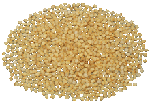SUGAR CORN
- Vegetable sugar corn - Zea mays convar. saccarata
- Gramineae family (Poaceae)
Sugar corn— is a tall-growing one-old-year plant that can be in a height of 3 m ( sometimes even more than 6 m) with a well-developed root system.
- At the bottom joints of stalk can be air roots.
- Upright stalk is in diameter 7 cm without domatium.
- Large linearly lanceolate leaf is in width of 10 cm and in a length of 1 m.
- Monoecious plant with imperfect flowers; man's flowers form large panicle at the top, woman's form spadices in leaf angels.
- Each plant usually has 1-2 spadices, sometimes more. Spadices are closely surrounded by foliate cover. Long pistillate stile go at the top of the cover. Wind spreads blossom dust from man's flowers to woman's and settling is started; at first caryopsis is formed.
- The shape of caryopsis is rather original as it is not longish as wheat one but cubic or roundish. They are situated in upright rows close to each other. One caryopsis can have 1000 seeds. Depending on variety they have different colour, shape and size; usually they are yellow but sometimes you can meet caryopsis with a reddish, violet, blue, and almost black tint.
Corn was brought in agrarian culture 7 -12 thousand years ago at the territory of modern Mexico. Ancient finding of corn on the territory of Oaxaca ( Gvil Nakitz cave) and Puebla ( cave near Teuakan town) dated 42050 and 2750 BC. Interesting fact that corn caryopsis were smaller in 10 times at that time and were no longer than 3-4 cm in length. International scientific team under the supervision of archaeobotanic Dolores Piperno from Smithsonian’s National Museum of Natural History and professor of anthropology Anthony Ranere from Temple University in Philadelphia found the first evidences that corn was domesticated about 8700 years ago in the valley Balsas in Mexico. It was grown from wild plant teosinte. Analysis of micro-fossils (starch of grains and fossil plants) that were found on a stone barrier against wind, called Shiuatoshtla provided direct evidence for the domestication of maize and plants of different species of the family Cucurbitaceae. The analysis was conducted with the participation of Irene Holst.
There are few theories about corn origin:
- It is a result of selection one Mexican wild corn, Zea mays ssp. Parviglumis; nowadays this taxon grows in Mexico and Central America. More likely that this crop appeared in river-basin Balsas on the South of modern Mexico. It is not impossible that 12% of genetic material corn received from another plant Z. mays. Ssp. Mexicana – introgressive hybridization.
- It is a result of hybridization of small cultured wild corn ( a little changed wild corn) with another type Z luxurians or L diploperennis.
- One of the taxon of Mexican corn was brought under cultivation for several times.
- Cultivated corn appeared by hybridization Zea diploperenni with some variety of Tripsacum.
Modern researchers accept the first hypothesis that was proposed by G. Bidl in 1939 and was grounded on experimental data. When corn was grown on small surfaces in Mexican high-mountain regions it was uniform according to genetic view. But from 15 century BC it started spread fast to Mesoamerica. For new weather conditions people needed new varieties. It was a motivation for intense corn selection and as a result in 12-11 century BC many new varieties of corn saw the world.










